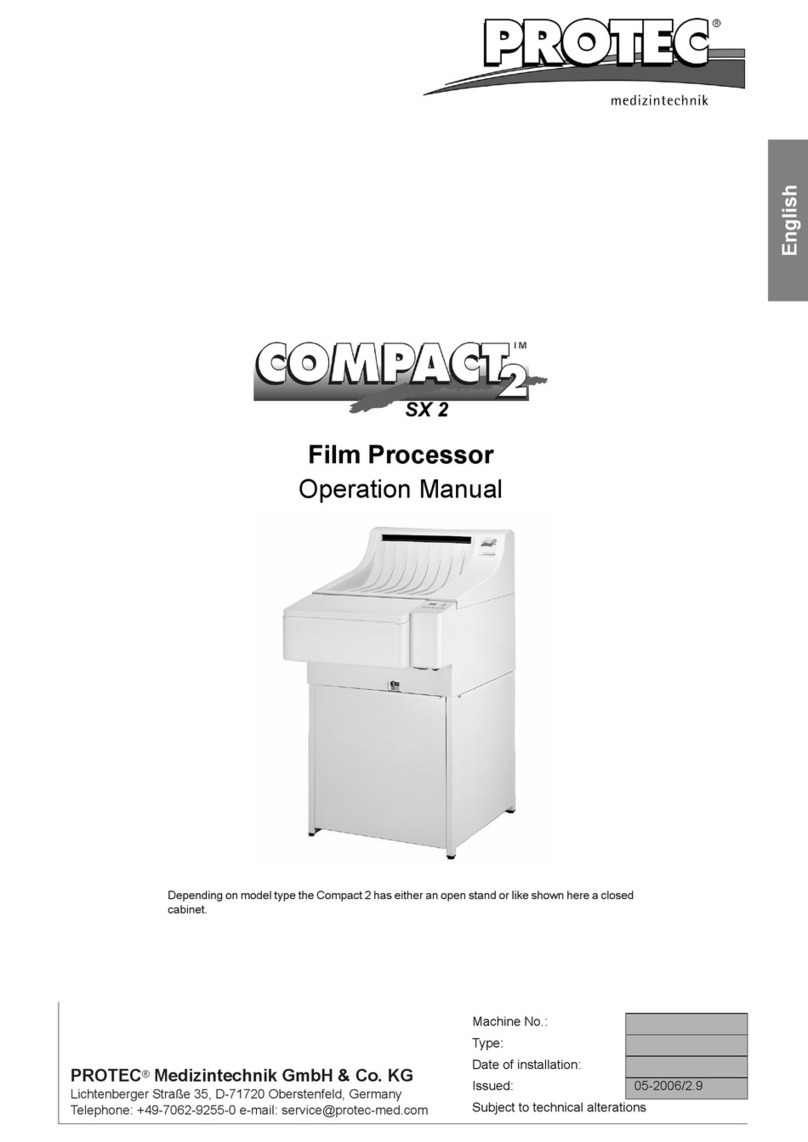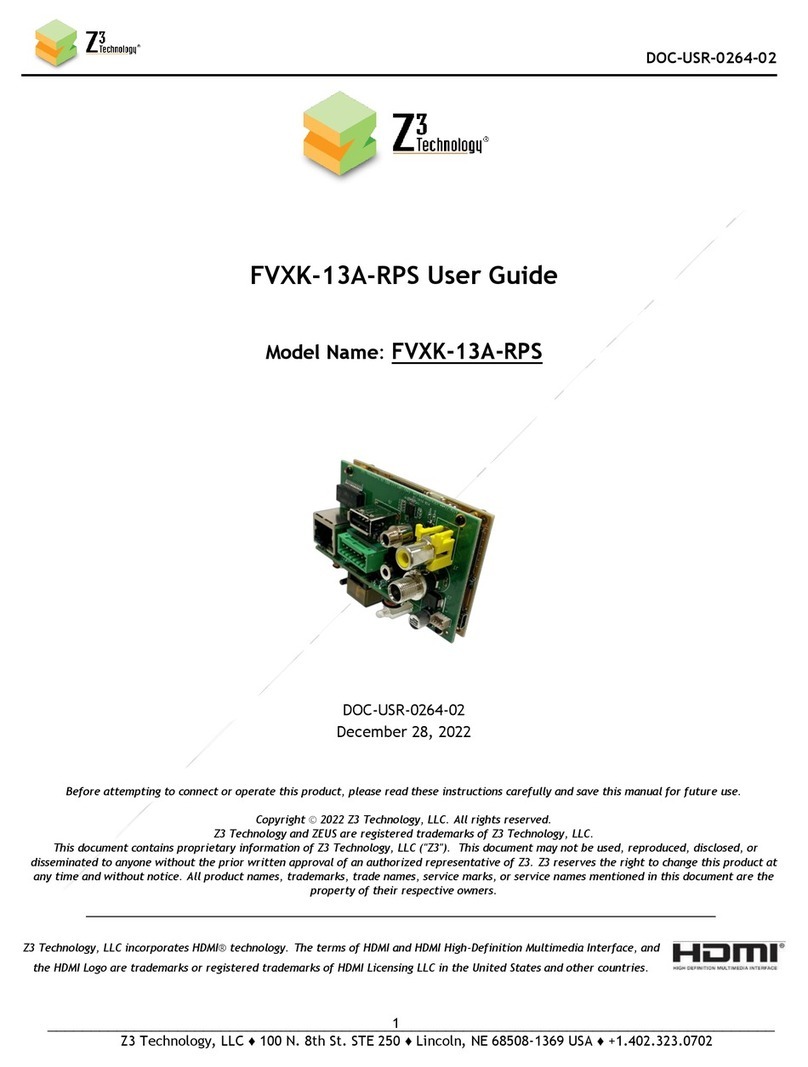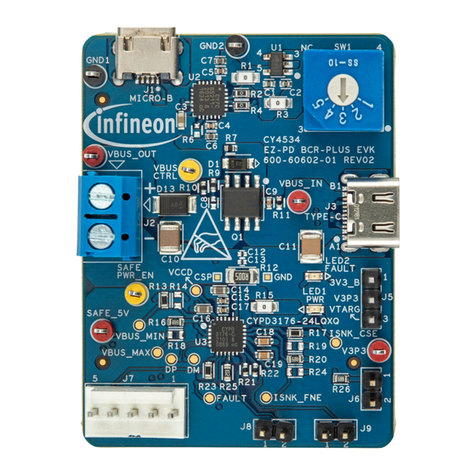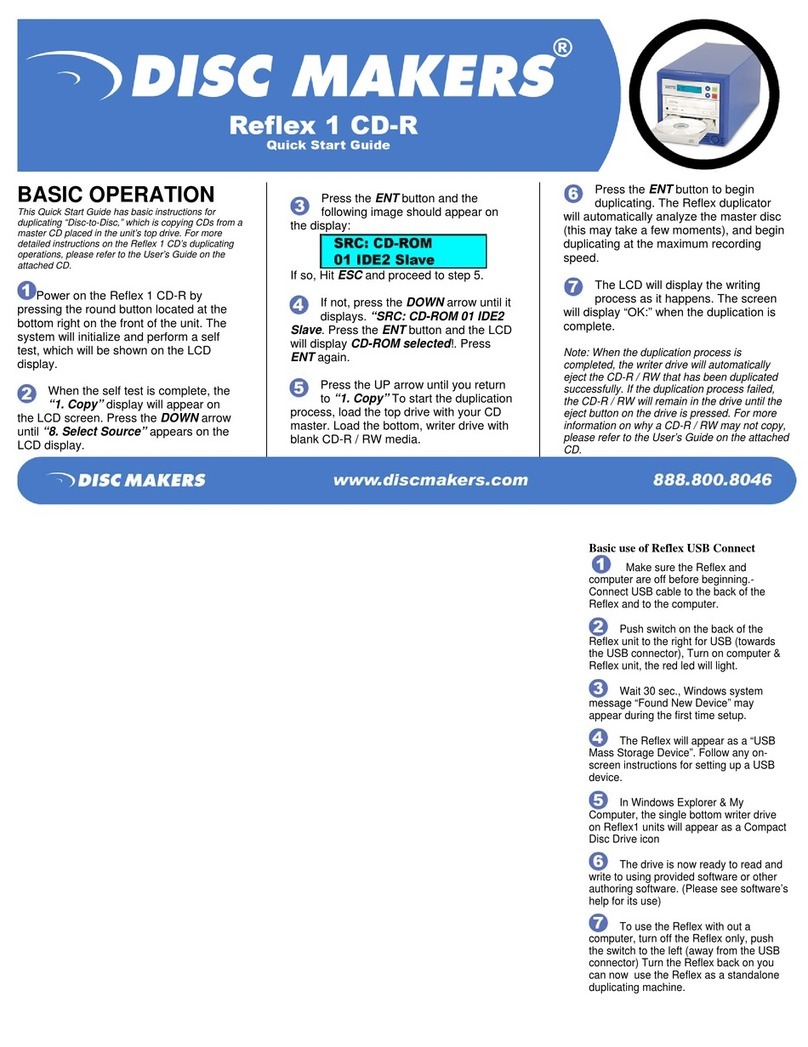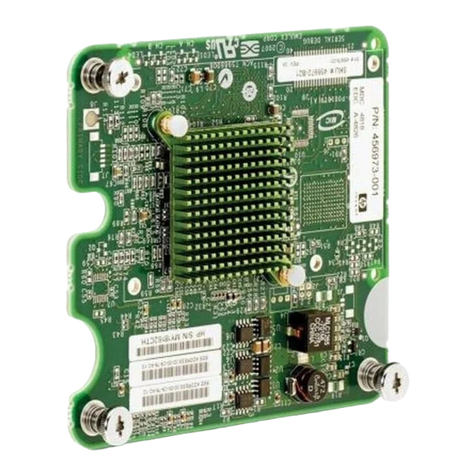Pro-tec OPTIMAX User manual

Machine No.:
Type:
Date of Installation:
Issued: 05-2006/3.4
Subject to technical alterations
PROTEC®Medizintechnik GmbH & Co. KG
Lichtenberger Straße 35, D-71720 Oberstenfeld, Germany
English
Film Processor
Operation Manual

2OPTIMAX®
EU-Declaration of Conformity ®
EU-Declaration of Conformity
PROTEC®Medizintechnik declares, that the product
Description: OPTIMAX
Machine type: X-Ray-Film Processor
Model no. 117x-y-0000
x is a number between 0 and 9, y is a number between 1 and 9
conforms to the following harmonized standards:
Safety: IEC 61010-1:2001 + A1:92 + A2:95; DIN 1988 T4:12/1988; UL 3101-1; CSA 22.2-1010-1
EMC: EN 50081 Part 1, 03/1993; EN 50082 Part 1, 03/1993
according to the regulations of:
• the Medical Device Directive 93/42/EEC “class 1”,
• the Low Voltage Directive 73/23/EEC and the
• EMC Directive 89/336/EG
PROTEC®Medizintechnik GmbH & Co. KG, Lichtenberger Straße 35, D-71720 Oberstenfeld, Germany
Supplementary
Guidelines:
• DIMDI: DE / 0000042967
• WEEE: DE 55471807
Place and date of issue
Oberstenfeld, 23. Mai 2006, Jochen Krupp (Technical Manager Analogue Systems)

OPTIMAX®3
Table of Contents
English
®
Introduction .......................................................................................................... 3
Technical Specifications ..................................................................................... 4
Safety Instructions............................................................................................... 5
Installation ............................................................................................................ 6
Initial Operation.................................................................................................... 9
Operation
Short overview and control panel ................................................................ 10
Switching the machine on............................................................................ 12
Stand-by mode ............................................................................................ 12
Bath temperature......................................................................................... 12
Display “Film feed”....................................................................................... 12
Manual pumping .......................................................................................... 12
Anti-crystallisation function / Time replenishment ....................................... 12
Automatic replenishment ............................................................................. 13
Rollfilms and paper films ............................................................................. 13
Care
Daily Care.................................................................................................... 14
Weekly Care ................................................................................................ 14
Thorough Cleaning ...................................................................................... 15
Maintenance / Disposal ..................................................................................... 16
Problems and Solutions
Troubleshooting Film Defects...................................................................... 19
Troubleshooting Machine Errors ................................................................. 20
Accessories ........................................................................................................ 21
Service Manual as appendix, see page 23
Copyright
© 2004 by PROTEC®Medizintechnik. All rights reserved. Any reproduction, out of
the limitation by the copyright law, needs written authorization by PROTEC®Mediz-
intechnik.
Information on Liability
This manual has been checked for correctness. The instructions and specifications
were correct at the time it was published. Future models may have modifications
without prior notice. PROTEC®Medizintechnik does not take responsibility for dam-
age caused direct or indirect by error, omission or non-conformity of the manual.
Caution (U.S.)
Federal Law restricts this device to sale by or on the order of a medical professional.
Introduction
The OPTIMAX®processor is a compact, automatic table-top processor. Due to the
precision roller transport system, both sheet and roller films can be processed. The
film materials are developed, fixed, rinsed and dried. The OPTIMAX®incorporates
an automatic film-registration and a Stand-by mode. The developing solutions are
temperature-regulated, circulated and automatically replenished.
This Operation Manual contains the most important instructions for installation, op-
eration and servicing of this machine. Please read the provided information careful-
ly to ensure reliable and satisfactory operation of your OPTIMAX®.

4OPTIMAX®
Technical Specifications ®
Technical Specifications
Film transport: Continuous roller transport system
Film formats: In general: Sheet and roll films up to 35.8 cm
(14.1’’) width;
roll films with leader from 70 mm (2.8’’) width;
smallest film format 10x10 cm (4x4’’).
Mammography Type 1171: For processing Mam-
mography Films.
Graphic-Arts Type 1172: With cassette box
(LxWxH) 35x13x12 cm (13.8x5.1x4.7’’) for
processing roll films.
Processing capactiy: 129 films 24x30 cm (10x12“) per hour (standard
model, film fed in crosswise)
Process time: Standard 90 s
Mammography 135 s
*Option 167 s
Linear speed: Standard 56 cm/min. (22 in/min)
Mammography 37 cm/min (14.5 in/min)
*Option 30 cm/min (11.8 in/min)
Developer time: Standard 25 s
Mammography 37 s
*Special 46 s
Tank capacities: Developer, fixer and washing 5 litres each (1.3 gal)
Circulation system: Developer and fixer are continiuously circulated by
a circulation pump
Replenishment: Automatic replenishment by film detection, in rela-
tion to film length
Developer temperature: Adjustable 28 - 37 °C (82.4 - 98.6 °F)
Fixer temperature: Adjusted to developer temperature by heat
exchanger.
Water connection: Permissible water pressure 2 - 10 bar
(29 - 145 psi), permissible water temperature
5 - 30 °C (41 - 86 °F).
Water consumption: 1.9 litres per minute (0.5 gal/min) when process-
ing.
Drain capacity: 7 litres per minute (1.85 gal/min)
Noise level: Less than 58 dB(A).
Heat emission: Stand-by: 0.1 kJ/s Processing: 1.4 kJ/s
Environmental condi-
tions:
1) Temperature 18- 40 °C (51,6 - 104 °F), venti-
lated room, room temperature should be lower
than set bath temperature.
2) Relative humidity lower than 80% up to 31 °C
(80 °F), linear decreasing to 50% at 40 °C (104 °F)
3) Height above sea level less than 2000 m
(6666 ft.)
4) Indoor use
Pollution degree: 2

OPTIMAX®5
Technical Specifications
English
®
* Depending on machine type and used gears processors have different speeds.
** Height incl. optional working table resp. base cabinet.
Safety Instructions
System protection: IP 20
Power source: Electrical specifications are indicated on model
nameplate.
Type 117x-1-0000: 220 - 240 V~, 8.8 A, 50 Hz.
Type 117x-2-0000: 220 - 240 V~, 8.8 A, 60 Hz.
Machine tested for overvoltage category II accord-
ing to IEC 1010 (EN 61010, VDE 0411)
Type 117x-4-0000: 110 / 120 V~ ±10%, 15 A,
60 Hz.Machine tested for overvoltage category II
according to UL 3101 and CSA 22.2-1010
Power consumption: Stand-by: 0.12 kWh
Processing: 1.4 kWh
Weight (processor): Empty 35 kg (77 lbs)
Filled 50 kg (110 lbs)
Dimensions (LxWxH): 77x59x42 (** 112) cm 30.3x23.2x16.5 (** 44.1)’’
Floor space required: 0.45 m2(4.8 sqft)
To ensure the safe operation of this processor, installation and use should
always conform to the instructions contained in this manual.
The developer and fixer chemicals used in the processor should be handled
according to the manufacturer´s instructions. In general: Non-diluted chemicals
are caustic. For this reason, chemicals should be handled very carefully. Avoid
contact with skin, always wear protective clothing, gloves and glasses when han-
dling the chemicals - for example, when mixing and refilling. Also when taking the
racks out for cleaning or servicing. In case of chemicals getting into the eyes,
rinse eyes immediately with cold, running water for approximately 15 minutes,
and contact a doctor afterwards. Inhalation of chemicals can be dangerous to
your health and should be avoided. For this reason, always ensure that the room
in which the processor is installed is adequately ventilated.
Environmental regulations regarding the storage and disposal of waste chemi-
cals should be obtained from the local water authorities and complied with.
Before opening the processor switch off the unit and unplug it from the electrical
socket. Service and repairs must be performed by trained service technicians
only. Use only manufacturers replacement parts.

Installation
6OPTIMAX®
®
Installation
1. Requirements for installation
a. Fresh water connection: Stop cock with 3/4" outer-thread diameter (washing
machine connection), Water pressure 2 - 10 bar (29 - 145 psi).
Drainage connection: Plastic tube - inner diameter 50 mm (2”) or larger. A
ventilated syphon which serves as odor preventor should be included in the
planning. The drainage tubes should be installed with a fall of minimum 5 %.
Local Water Authorities regulations should be complied with.
b. Electrical connection: Fused wall socket with ground connection according to
electrical data (see Technical Specification, page 5). It is also required to
install a ground fault interrupt (with 25 A / 30 mA nominal error current).
2. Set up of processor
Unpack the Processor. Remove cover and transport securing brackets on the sides
of the roller racks. Remove roller racks - start with the dryer rack.
In 220-240 V version the OPTIMAX®is delivered as a tabletop processor with a two
part floorplate. If the machine is upgraded with the optional stand or cabinet, the
small plastic strip has to be removed.
In 110-120 V version the OPTIMAX®is delivered as a tabletop processor with a
three part floorplate. If the machine is upgraded with the optional stand or cabinet,
both small plastic strips and the metal plate have to be removed and a special main
plate must be reconnected.
Table-top installation
In the event that the processor is to be installed on a work top or table, the adjust-
able feet should be levelled.
Installing on processor stand or base cabinet
In the event that the processor is to be installed on the stand or cabinet (optional
accessory), the processor will be mounted directly to it. Mount processor according
to manual included with stand or cabinet (the adjustable feet inside the accessory
bag are not required).
Finally the processor needs to be leveled:
Place level across the sidewalls of processor and adjust the leveling feet accord-
ingly. Replace the racks into the processor and close the latches.
Electrical connections should be carried out according to reg-
ulations by an electrician.
Attention!
Machine should not be installed on table-top without adjusta-
ble feet, as this would block the ventilation openings under the
machine and cause overheating.

OPTIMAX®7
Installation
English
®
3. Connecting the processor
Water connection: Connect the water hose which comes out from the processor’s
back to the fresh water supply.
All other hoses (see diagram page 8): Connect the enclosed hoses according to
color system onto the front of the machine. Put hose clamps (enclosed in accessory
bag) over hose end, before attaching to connection. Warm up hose end (with hot
water or lighter) and push onto the respective connection. Finally push clamp over
hose and connection.
Cut hoses to required length. Then integrate the stop cocks into the three drainage
hoses in such a position, that they are easy to reach.
Connect the suction pipes to the hose ends for the replenishment tanks using hose
clamps. Put suction pipes through cover opening into respective replenishment
tanks and snap them in.
The overflow and drainage hoses from the developer and fixer should be guided
into their respective collecting containers.
The overflow and the drainage of the water can either be guided into the drainage
syphon or into respective collection containers.
Drainage and
collecting
containers
min. 70 cm

Installation
8OPTIMAX®
®
Hose connections
Danger of Overflow!
Use the included cable ties (accessory bag) to secure the hos-
es. Fix all hose ends which guide into syphon or collecting
container, so that they do not drop into the liquid.
Very important:
The hose piping should be straight (without the hoses going
up and down) with a constant fall. The hoses should be as
short as possible and without bends and kinks. This is very
important for the water overflow hose. Bad piping work will
cause the machine to overflow!
Inform yourself of the local water board regulations regarding
drainage. These regulations may differ from information in
this manual, but they should be complied with.
If the machine is installed table-top, ensure that the table is
stable enough and does not wobble.
DEV FIX HO
2
Pay attention to the correct color connections:
Developer: red
Fixer: blue
Water: clear
Developer (red) Fixer (blue) Water (clear)
Replenishment tanks
Outlet
Overflow
Overflow
Outlet
Outlet
Overflow
Replenishment tanks
Replenishment
Overflow
Outlet
Overflow

OPTIMAX®9
Initial Operation
English
®
Initial Operation
1. Test run
a. Close the three drainage stop cocks and fill the tanks and replenishment con-
tainers with water. Open water inflow tap. Connect electrical socket and
switch the machine on. Water now flows into water tank. The circulation pump
activates. If fluid does not flow, an air lock may be present. Momentarily open
the drain hose valves to ventilate the system.
b. Ventilation of the replenishment pump:
Set temperature dial to position “Manual pumping”. Keep dial to this position
until no more air bubbles rise in the tanks.
c. Ventilation of the circulation pump:
If air is in the circulation pump, a loud running noise can be heard. Switch the
machine off again. Open the stop cocks of the developer and fixer for five sec-
onds and switch machine on again. Repeat this procedure until no more air
bubbles are visible in the developer and fixer baths and until the circulation
pump runs quietly.
d. Check all hose connections for leakage. Switch machine off and drain water
out.
2. Fill processor with chemicals
Prepare chemicals inside the replenishment containers according to manufacturers
instructions.
Fill up processor manually
By using a suitable container, pour chemicals into the respective tanks. First the fix-
er and then the developer. Caution: when filling, be sure that chemicals do no
splash from one bath into another. When fixer solution is mixed with developer so-
lution, the developer chemical is destroyed.
Snap each suction pipe into the respective cover of it’s replenishment container and
close it carefully. Place containers under processor.
Using replenishment pump
Filling of processor can also be done by use of the replenishment pump (this takes
much more time). Snap each suction pipe into the respective cover of it’s replenish-
ment container and close it carefully. Place containers under processor. Now set
temperature dial to “Manual pumping”. Keep dial in this position until tanks are filled.
After 20 minutes this function stops automatically - to restart a cycle, turn dial to an-
other position and return to “Manual pumping”. Limitation: The function may fill up
tanks of developer and fixer to different levels. This may be due to different causes.
If this happens, then use a suitable container to fill up the tanks completely.
Important!
Processor should not be run dry!
Upon commissioning and every refilling the pumps must be
vented.

10 OPTIMAX®
Operation ®
Operation
Short overview and control panel
*Only machines with cassette box:
When processing roll films in cassettes, pull approx. 10 cm of film out of the cas-
sette and fold the corners. Place cassette into cassette box and feed film into the
infeed. Notice that on processors with cassette box, the film switch is located in the
middle of the infeed.
LED displays
•Film feed
Wait with the next film until light goes off.
•Power
When power is on the LED lights up.
•Bath temperature
Flashes when temperature is not reached.
Temperature dial
Manual pumping
Important!
Safety function stops film transportation when cover is re-
moved. Therefore keep cover placed on the machine when
processing films.
28
32
33
34
35
36
37
29
30 31
®
Film input Light protection cover
Control panel
Film
switch
Developing
Replenishment Developer
Power switch
Replenishment Developer
*Roll film cassette

OPTIMAX®11
Operation
English
®
Before use...
1. Close water-drainage stop cock.
2. Open water tap.
3. Switch processor on.
4. Check liquid level in replenishment and drainage collecting containers.
5. Wait until the developer temperature is reached. If the temperature has not
been reached, the bath temperature light is flashing.
6. Run cleaning films through processor.
Working procedure
7. Processing films:
Open light protection cover. Important: Put film first on left side of feed tray
and then feed in. During processing films please watch the display “Film
Feed”. If this is lit, wait until it goes off again and an audible tone can be
heard, before inserting the next film.
After work...
8. Switch processor off.
9. Close water tap.
10. Open water-drainage stop cock and drain water out of the machine.
Attention:
Upon first operation and each refilling of a developer check
the function of the circulation pump and vent the pump if re-
quired (see page 9).
Film exit
Drying
Replenishment Fixer
Fresh water inflow
Washing
Fixing
Do not place any
object on the proc-
essor.

Operation
12 OPTIMAX®
®
Stand-by mode
When no film is being processed, the machine switches to Stand-by. The chemicals
remain at a constant temperature. The film transport and water inflow activate at in-
tervals to avoid crystallization of the chemicals on the transport rollers. Entry of the
next film is possible at any time.
Switching the machine on
The processor is switched on at the main power switch on the front side. After
switching on, the water tank will be filled up and a replenishment cycle will be car-
ried out. The developer will be heated up. Until the tempearture is reached the LED-
display “Bath temperature” will be flashing. When the processor is ready and the
bath temperature reached, a long signal tone can be heard.
Bath temperature
The processor heats up the chemicals automatically to the dial-set temperature.
When this temperature is reached for the first time after switching on the machine,
a long signal tone can be heard. This is also the case when the temperature is
changed by the dial switch.
If the difference between actual and dial-set temperature is more than 1 °C, the
bath temperature LED will flash. If a film has been fed in and the temperature is not
reached, a warning sound will be heard.
Display “Film feed”
If films are fed into the processor without clearance one after an other, then this may
cause a film jam. The light “Film feed” is on during feeding of a film. After the film
has been fed in completely the light goes off. Additionally an audible tone indicates
that the next film can be fed in.
Manual pumping
The function “Manual pumping” activates the replenishment pump and it pumps
chemicals into the tanks in addition to automatic replenishment. Turn the dial to the
position “Manual pumping” and chemicals will be pumped into the tanks. This func-
tion is only available during stand-by (no film in process). If the dial is left in this po-
sition, the pumping function is stopped automatically after 20 minutes. To restart a
cycle turn dial to a temperature and return to “Manual pumping”.
Please note: Films cannot be processed when dial is set to “Manual pumping”. Also
bath temperature is set automatical to 28 °C during “Manual pumping”. After ending
the manual pumping the temperature must be set again by turning the dial. It takes
some time until the temperature is reached (look at the bath temperature display).
Anti-crystallisation function
During the stand-by mode, the film transport, the dryer ventilation, the dryer heater
and the water inflow are activated every 20 minutes for a period of 20 seconds. This
prevents the build-up of crystals on the rollers.
Both chemical pumps - fixer and developer - are driven parallel
by only one motor and therefore they operate in unison.

OPTIMAX®13
Operation
English
®
Time replenishment (Anti oxidation function, Flood replishment)
During the stand-by, the developer chemicals are subject to change which causes
their deterioration. By means of the time replenishment, a replenishment cycle is
activated after 60 minutes without replenishment. The pump runs for 15 seconds.
With this function, the quality of the developer chemicals are maintained even when
standing idle for long periods.
Automatic replenishment
Depending on the processed amount of films the chemicals are replenished auto-
matically. This is done by pumping chemicals from the replenishment containers.
By means of the film-detection switch at the film feed tray, the surface of the proc-
essed films are calculated and after 20,25 m2a replenishment cycle of 40 seconds
duration is automatically activated. The replenishment quantity per cycle (at pump
setting 100 %) amounts to 150 ml. The chart below shows the replenishment rate
in ml per m2surface in reliance on film width and setting of the pump.
*Setting at 50 Hz current resp. settings at 60 Hz current are in brackets
**Standard setting
Rollfilms and paper films
Rollfilms can be transported into the machine when a leader film (10x10 cm) is at-
tached, that has been prepared with a chemical resistant adhesive tape.
Replenishment Rates
Film width Setting of replenishment pump*
100%** (85 %) 75 % (62 %)
35 cm 600 ml/m2450 ml/m2
24 cm 870 ml/m2650 ml/m2
18 cm 1150 ml/m2875 ml/m2
Rollfilms without leader films and paper should be folded on the corners as per
diagram displayed on the right.

Care
14 OPTIMAX®
®
Care
Daily Care
Before use...
• Remove dirt and dust from film feed tray with soft, lint-free cloth.
• Run 2 - 3 cleaner films through processor to remove all accumulated dirt and
dust from the rollers.
• Check the fluid level in the replenishment containers and if necessary refill.
After use...
• When work has been completed at the end of the day, drain water out of the
machine. This avoids the growth of algae in the water.
Weekly Care
The developer chemicals cause residue buildup in the machine. This residue has a
negative effect on the developing process of the film material. For this reason the
processor should be regularly cleaned. Proceed as follows:
1. Switch machine off and remove cover.
2. Loosen the securing latches (red, blue and beige) of the drive shafts of each
roller rack at the right side.
3. Remove the roller-racks. First of all remove the large dryer-rack (beige). The
racks are easier to remove and insert when they are slightly tilted. Use the
grey drip catcher forms to ensure that no chemicals splash when being car-
ried. Then remove the fixer (blue) and developer (red) racks in sequence.
4. Rinse all racks thoroughly under warm running water and then leave to drain
off. It is advisable to use a soft sponge (do not use scouring-pad, as this
would scratch the rollers) and remove any dirt from the rollers.
5. Replace the racks: Red = Developer, Blue = Fixer. Beige = Washing/Drying.
Ensure that the racks are firmly installed and do not forget to close the secur-
ing latches on the drive shafts.
6. Replace machine cover and ensure it is securely closed.
7. Clean processor outer shell with damp cloth. Do not use aggressive cleaners
or solvents.
Attention: To prevent damage to the processor, avoid liquid
contact, except for designated areas such as the processor
tanks. Use extreme care to prevent any liquid contact with the
processor controls.
Please note: When removing the Rinsing / Drying roller-rack,
ensure that no water gets into the film dryer air channel.

OPTIMAX®15
Care
English
®
Thorough Cleaning
Every three months (maybe earlier) a thorough cleaning is necessary, depending
on the quantity of films processed. Tank cleaners are available for developer and
water baths. The fixer bath is cleaned with water. When preparing chemical tank
cleaners, follow manufacturers instructions explicitly.
How to proceed:
1. Switch the machine off and empty all tanks by opening the stop cocks.
2. Remove machine cover. When all tanks are emptied, close stop cocks again.
Now fill the fixer tank with warm water. Prepare cleaner solutions for devel-
oper and water baths and fill into respective tanks.
3. Remove suction pipes from the replenishment containers and place them in a
deep container filled with warm water. Attention: Do not add chemical clean-
ers here!
4. Close machine cover and switch machine on.
5. Start film transportation and keep running for 10 to 20 minutes. To start the
film transport, place a film on the feed tray so that it activates the film switch
but will not be pulled into the processor. During the operation with water, the
installed roller racks will be cleaned.
6. Important: After completion of tank cleaning, the tank should be rinsed thor-
oughly with clean water. To do this, fill the machine with fresh water twice and
each time, let the machine run for a 10 minute period. Empty the tanks and re-
close the stop cocks.
7. Take out the roller-racks and rinse them thoroughly with running water.
Remove remaining dirt from the rollers by using a sponge and clean thor-
oughly. Doing this, the rollers can be turned by turning the drive shaft.
Remove the sheet metal covers from the dryer rack and clean the rack in
warm water diluted with dishwashing soap, and rinse well after cleaning.
Reinstall the roller-racks in the machine.
8. Refill the tanks with respective chemicals. To avoid accidental contamination,
carefully refill the fixer tank first. If any fixer inadvertendly spills in the devel-
oper tank, thoroughly clean the developer tank and then refill the developer
tank. Replace the suction pipes into the replenishment containers. In certain
circumstances the circulation system must be ventilated: see page 9, item 1c.
9. For quality check, process test films.
Before You Go on Holiday...
When the processor will remain off and unused for periods longer than 2 weeks, the
processor tanks should be emptied. Immediately after draining the chemistry from
the tanks, the drain valves should be closed and water should be added to each
tank. Upon return and prior to use, the processor should be cleaned and filled with
fresh chemistry.
Attention: Do not use alcohol containing solvents to clean the
machine!
Colour changes in the containers are caused by the properties
of the chemicals and no cause for concern!

Maintenance / Disposal
16 OPTIMAX®
®
Maintenance / Disposal
Maintenance Protocol
Installation
Parameters Set
Maintenance Performed (see page 17)
Name: Machine type: Serial number:
Technician: Training: by:
Telephone: Date: Guarantee until:
Developer temp.: Dryer temp.: Cycle time:
Dev. reg. volume: Dev. reg. volume: Anti-oxidation:
Developer: Fixer: Film type:
Changed by: Date:
Developer temp.: Dryer temp.: Cycle time:
Dev. reg. volume: Dev. reg. volume: Anti-oxidation:
Developer: Fixer: Film type:
Changed by: Date:
Developer temp.: Dryer temp.: Cycle time:
Dev. reg. volume: Dev. reg. volume: Anti-oxidation:
Developer: Fixer: Film type:
Changed by: Date:
Maintenance work
performed
Maintenance work
performed
Maintenance work
performed
Maintenance work
performed
Maintenance work
performed
Date: Date: Date: Date: Date:
Name: Name: Name: Name: Name:
next maintenance: next maintenance: next maintenance: next maintenance: next maintenance:
Maintenance work
performed
Maintenance work
performed
Maintenance work
performed
Maintenance work
performed
Maintenance work
performed
Date: Date: Date: Date: Date:
Name: Name: Name: Name: Name:
next maintenance: next maintenance: next maintenance: next maintenance: next maintenance:
Maintenance work
performed
Maintenance work
performed
Maintenance work
performed
Maintenance work
performed
Maintenance work
performed
Date: Date: Date: Date: Date:
Name: Name: Name: Name: Name:
next maintenance: next maintenance: next maintenance: next maintenance: next maintenance:

OPTIMAX®17
Maintenance / Disposal
English
®
Recommended Maintenance Work:
1. Functional check
film intake / film transport / replenishment / bath heating / dryer heating / water supply
2. Cleaning
2.1. Switch off machine, remove cover
2.2. Empty all three tanks
2.3. Close drain cocks and fill tanks with water
2.4. Install cover, switch machine on
2.5. Fill two additional vessels with water, put suction pipes into these vessels and activate replenishment for at
least two minutes (to remove residues of chemicals from replenishing hoses)
2.6. Switch machine on for a few minutes
2.7. Switch machine off
2.8. Empty all tanks
2.9. Prepare tank cleaning agent for developer and water tank according to manufacturer´s instructions
2.10. Fill developer and water tank with tank cleaning agent (do not use the replenishment pumps to do so)
2.11. Fill fixer tank with water
2.12. Place suction pipes into empty tanks
2.13. Install cover, switch machine on
2.14. Wait until the operating temperature is reached, approx. 30 °C (observe information concerning temperature,
time, cleaning procedure contained in the datasheet of the tank cleaning agent)
2.15. Activate manual programme and transport
2.16. After approx. 15 minutes (observe information concerning temperature, time, cleaning procedure contained in
the datasheet of the tank cleaning agent) switch film transport off
2.17. Remove cover, neutralise developer tank (observe information concerning temperature, time, cleaning proce-
dure contained in the datasheet of the tank cleaning agent)
2.18. Switch machine off
2.19. Empty all three tanks
2.20. Fill machine with water and switch it on
2.21. Put suction pipes into vessels with water
2.22. Activate regeneration pumps for at least five minutes
2.23. Check all pumps for tightness
2.24. Switch machine off
2.25. Drain tanks
2.26. Fill tanks 3/4 with water
2.27. Switch machine on
2.28. Activate replenishment pumps manually until tanks overflow
2.29. Activate film transport for a few minutes
2.30. Switch machine off and drain all three tanks
Attention:
Never start the machine up unless it is filled with liquid!
Attention:
Do not use chlorine containing cleaning agents!

Maintenance / Disposal
18 OPTIMAX®
®
2.31. Repeat item 2.20 to 2.30 if required (observe information e. g. concerning temperature, time and cleaning pro-
cedure outlined in tank cleaner datasheet)
2.32. Remove roller racks from the machine and remove dirt under flowing water using a soft rag or sponge
2.33. Remove residual dirt particles in tanks and rinsing gutters.
2.34. Clean all toothed gear wheels, axles, bearings and rollers, check them for damage (replace if required)
2.35. Remove light protection flap and wipe its underside using a soft rag
2.36. Clean inlet plate using a soft rag
2.37. Reinstall light protection flap
2.38. Align roller racks and re-insert them in machine
2.39. Fill machine with chemicals
2.40. Switch machine on
2.41. Adjust bath temperature to previously adjusted value
2.42. Feed cleaning film (approx. 4 pieces)
2.43. Check function as described under item 1.
2.44. Approx. 15 minutes after reaching of the set bath temperature, measure it for confirmation and re-calibrate if
required (see operating manual page 39)
2.45. Perform sensitometric test
Please dispose of all old devices in an environmentally
friendly manner.
Old devices contain materials which need to be recycled. Please
have them collected separately and recycle appropriately.

OPTIMAX®19
Problems and Solutions
English
®
Problems and Solutions
Troubleshooting Film Defects
Your processor has been constructed for long term use. However, if irregularities
occur, the following information can help to solve the problem. Please check the fol-
lowing items before calling for service.
Films are too light, not enough density
• Bath temperature is too low.
• Developing time too short.
• Exposure time is too short.
• Replenishment rate of developer too low.
• Developer is exhausted or over-diluted: Drain and replace old developer with
fresh developer.
• Fixer solution has been mixed into developer: Renew. Thoroughly clean and
rinse the developer tank before refilling.
• Circulation system is not operating properly.
Films are too dark, too much density
• Developer temperature too high.
• Developing time too long.
• Exposure time is too long.
• Replenishment rate of developer too high.
• Developer chemicals are too concentrated, mix with new developer.
• After replacing the chemicals: Starter is missing.
• Circulation system is not operating properly.
Films will not dry
• If warm air comes out of air channel in the dryer, chemicals and film type
should be checked.
• Fixer solution is exhausted or diluted.
Film has a yellow-green surface.
• Not fixed correctly. Check the film type and fixer chemistry.
• Fixer solution is exhausted or diluted. Replenishment rate of fixer is too low.
Scratches, pressure marks, dirt on film
• Prior to processing films, run cleaner films through the processor.
• Pressure marks caused by careless handling, finger nails etc.
• Rollers are dirty. Clean tanks and roller racks.
Cloudy film
• Level in developer is too low.
• First guide bar of fixer rack is dirty (condensation or crystals). Clean roller-
racks.
• Developer is old or circulation not working.
• For single emulsion film, feed films emulsion (dull) side up.

Accessories
20 OPTIMAX®
®
Troubleshooting Machine Errors
Machine does not switch on
• Ensure that electrical plug is firmly inserted into socket.
• Ensure that electrical socket has power supply by testing with an appliance
(e.g. tablelight).
Film will not feed in but the dyer fan works
• Place cover firmly on machine, ensuring that the cover switch on the right
front side has been activated.
Machine does not start automatically
• Film switch, located on the left side of the feed tray, has not been pressed
down. Feed in the film to activate the switch.
Developer temperature too low
• The temperature dial is set between two positions.
Replenishment pump does not pump
• Check whether the replenishment containers are full and that the end of the
suction pipe is positioned under the liquid level.
• Check whether there is air in the replenishment pipes. If this is the case, then
check the pipe connections.
Rinsing water does not flow
• Open water ball valve.
• Water pressure in the water system is too low: Minimum pressure 2 bar (29
psi).
Water tank overflows
• Water drainage hose (overflow) is bent. The hose end should be positioned
above the drainage level in the syphon (see diagram on page 8).
• Water drainage in the tank, hoses and connections should be checked for
blockage and dirt/residue build-up. The drainage hoses should have a con-
stant fall.
The film does not transport correctly
• Film is fed in and gets caught in the machine: Check the positioning of the
racks in the machine and make sure that the latches are closed.
Important notice:
Ensure that the racks are firmly installed and keep the secur-
ing latches on the drive shafts closed.
Don’t operate processor with empty replenishment tanks.
After a long machine shut down check developer and fixer lev-
els and refill if necessary.
Table of contents
Other Pro-tec Computer Hardware manuals
Popular Computer Hardware manuals by other brands

Apogee
Apogee X-Video Card datasheet
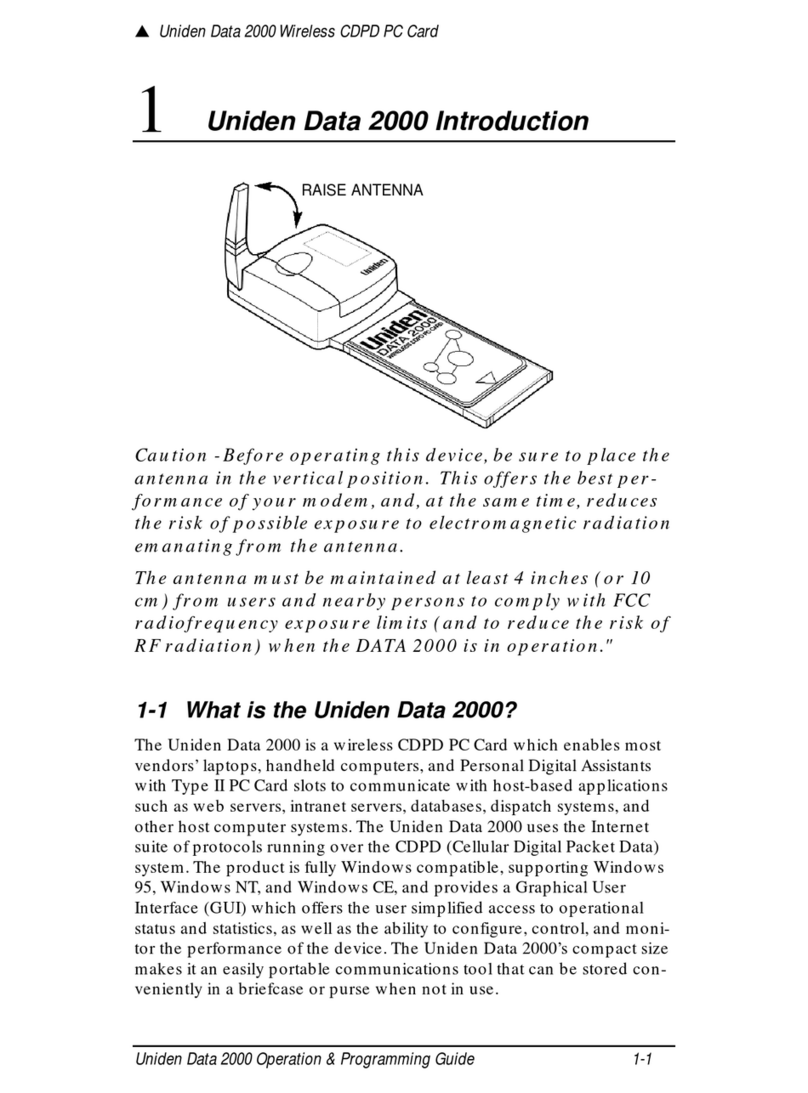
Uniden
Uniden Data 2000 manual
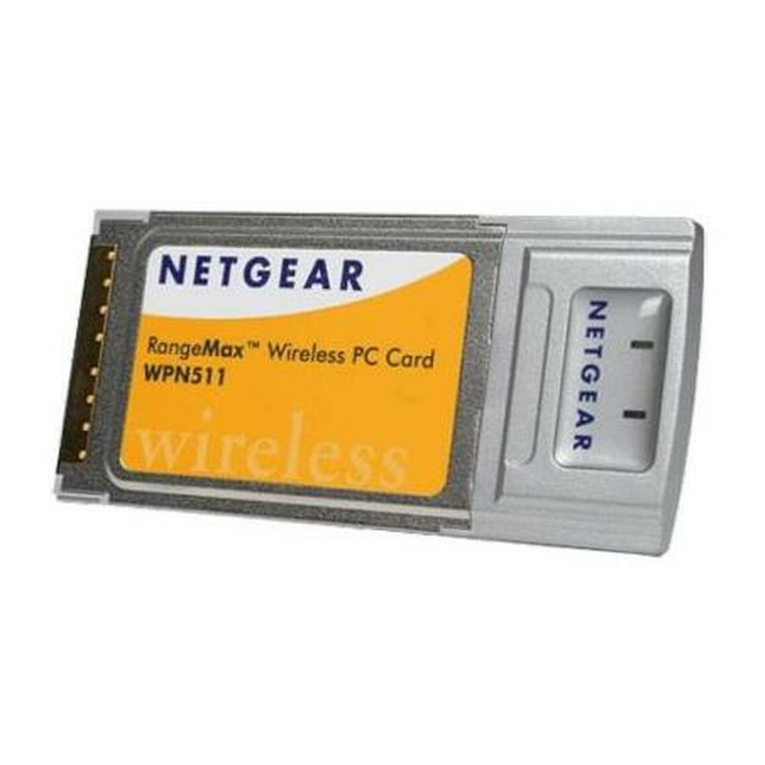
NETGEAR
NETGEAR WG511U - Double 108Mbps Wireless A+G PC Card user manual
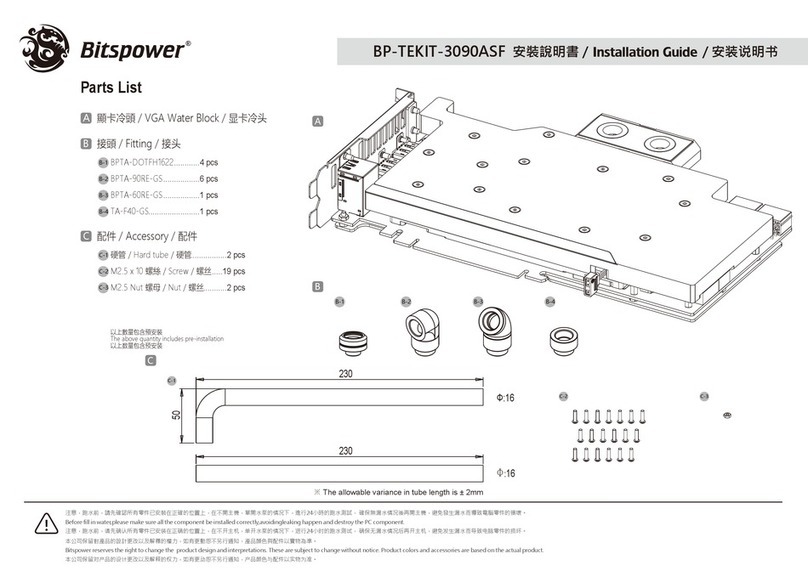
Bitspower
Bitspower Titan Series installation guide
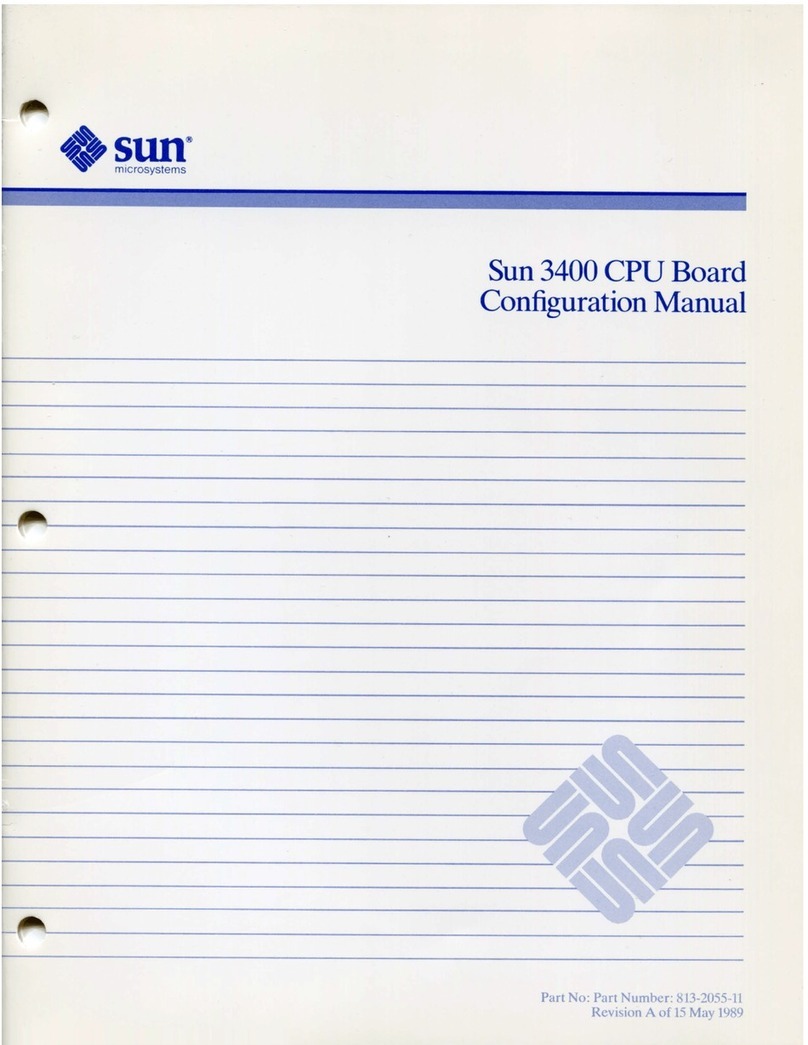
Sun Microsystems
Sun Microsystems 3400 Configuration manual
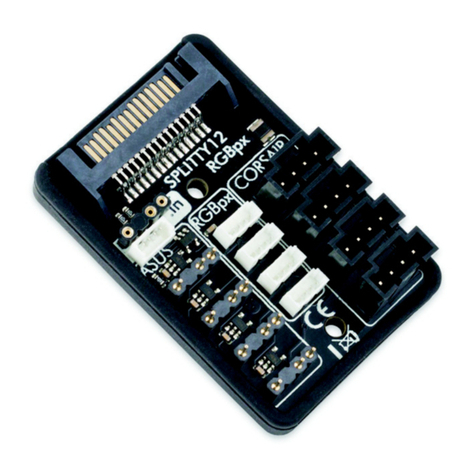
Aqua Computer
Aqua Computer RGBpx Splitty12 ACTIVE instruction manual
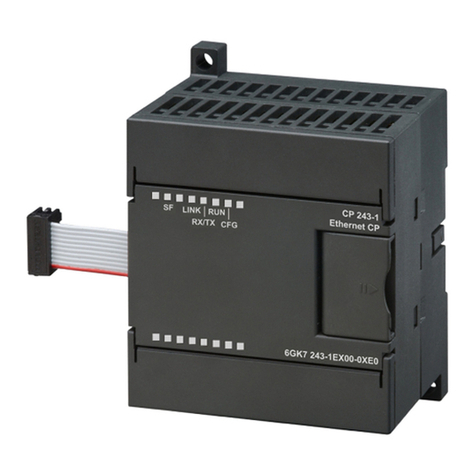
Siemens
Siemens SIMATIC NET CP 243-1 Technical manual

ELAN Microelectronics Corporation
ELAN Microelectronics Corporation EM78612 specification

SYSOLUTION
SYSOLUTION Y50 Universal instructions
TELINK SEMICONDUCTOR
TELINK SEMICONDUCTOR TLSR8278DG48D user manual
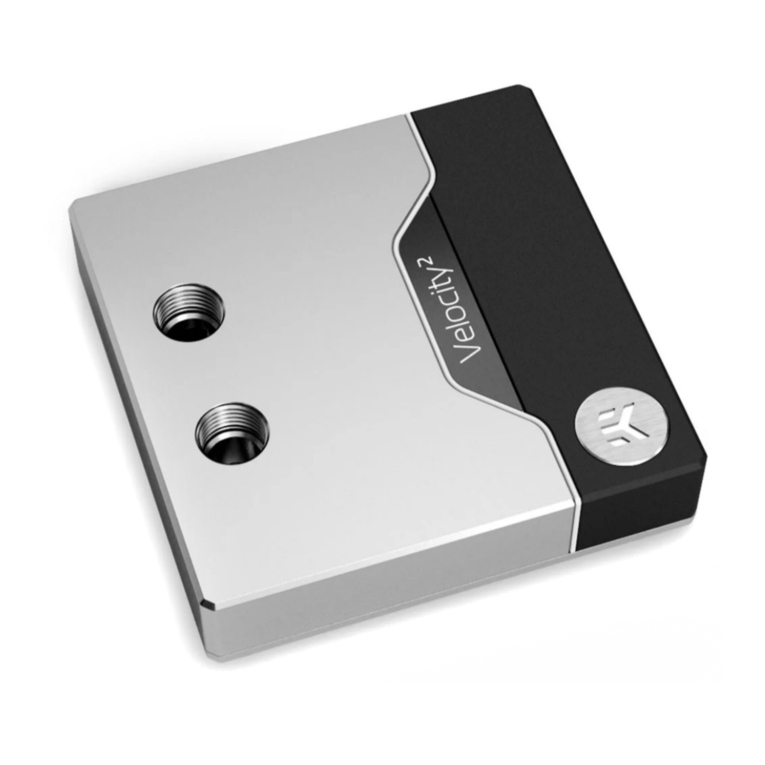
EK-Quantum
EK-Quantum Velocity 2 D-RGB AM4 user manual

Krüger & Matz
Krüger & Matz Air Shair2 owner's manual



